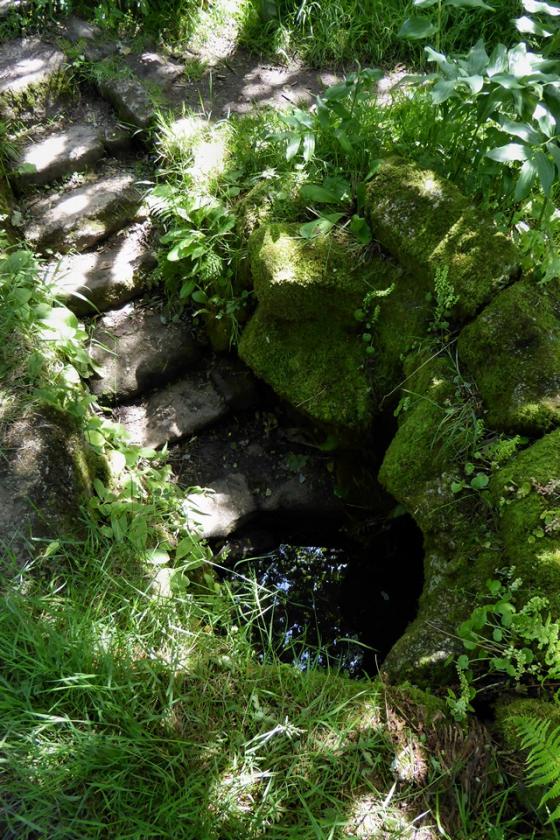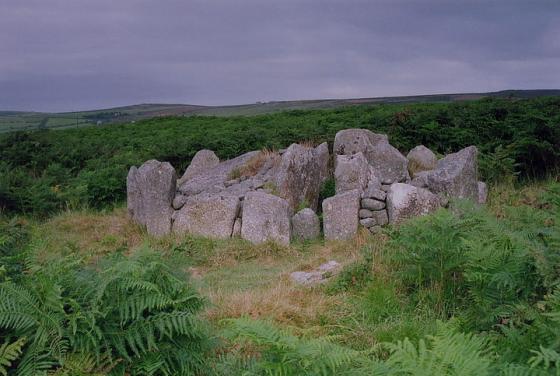



The rickety gate leading to the well

One of the most peaceful places I’ve been to!



4/03

4/03
5th October 2003
After a false start, confused a little by the directions here, I found the stile easily enough. Park by the Alsia Farm entrance drive, and walk down (West) past the Mill. The stile is on the left, opposite what would be a parking place if not blocked off by stones. Climb up the stile steps and a totally unexpected view awaits. A pleasant meadow with a large informational sign leads to the far field boundary, where another small sign points to the (private) footpath leading to the well. Down the hill, the bracken and brambles open up on the right, and turning right into the brambles again reveals the rusty gate by the well.
Access: The initial stile is quite high, but the walk is reasonable across grassland. The return trip is uphill, and the stile can be tricky to return down to the road.
After driving up and down the lane, past Alsia Farm, past Alsia Mill we eventually found the style that leads over the hedge. The directions we had said “in a field just past Alsia Farm on the left” – so, with Alsia Farm on our left, we scoured a completely empty field! One compensation was the strange engraved cross behind a pond directly opposite the entrance to the farm – very nice! Anyway – up the road, round the corner, over the style. The landowner (very nice man) came to greet us on both of our visits to show us the way across the field. He has very kindly also put signs up pointing out the footpath to Bosfranken and the well. Down the hill, just on the right, is a rusty old gate, apparently to keep the animals out (fair enough – what animals exactly! ;o) We saw none!) Inside the gate is a place out of time; out of synch with the rest of the world. It’s beautiful. Slate slabs lead to the tiny, undisturbed well and stream. The flowers growing around are so colourful (at the right time of year, I suppose!), as are the clouties hanging from the branches. We sat for a while listening to the faint trickling of the water, and could have stayed forever. Meanwhile, back in the real world – we had to leave, but will be back. You can’t help but get a feeling of calm, and sense an accumulated power here.
A visit here is a must if you are in Southwestern Cornwall.If you are following your map you will have turned off the main road,you will come to a wooded valley with an old mill,don’t ask here but carry on up the hill.
You can park at the end of the farm drive,the farmer will give you directions and ask you to keep to the edge of the fields.After a stroll of about half a mile you come to this wonderful tranquill other worldly haven,Wash your arms and feet and the aches vanish like magic.On a warm summers day it is easy to get lost in time and find it very difficult to leave.
‘We know not if “this fount” is still regarded as a holy well; but many years ago we have often heard an aged lady, who was born and bred near Alsia, and was well acquainted with legendary lore and old customes of the district, say that in her younger days the Saint’s Well of Alsia was almost as much frequented on the three first Wednesdays in May as the noted well of Chapel Uny. Mothers came from far and near with their weak and rickety children that they might be strengthened by being bathed in its waters. Moreover, the same old lady to whom we are beholdened for many of the incidents of the legend, Nancy Trenoweth (the fair daughter of the miller of Alsia), informed us that it was not unusual for these pilgrimages to be the occasion of a fight between the women of Alsia and the pilgrim mothers, when the good housewives caught the strangers dipping their precious babes into the enclosed part of the well, or the place from which the neighbours drew their drinking water.‘
A cross formerly stood near this fountain, and its socketed pedestal was until lately to be seen.
The Alsia Well was also one of the wishing or divining sort. Of a summer’s evening scores of maidens might be seen around it, eager for their turn to see what sweethearts would be united or parted, which they discovered by the fall of pebbles or pins. As the articles sank near or apart so their future was foretold; and the number of bubbles raised bespoke the number of years before the happy or unhappy issue could befall. Another method of consulting the spirit of the well was by floating bramble leaves on it. -- T.Q.C.
From ‘Ancient and Holy Wells of Cornwall’ by M and L Quiller-Couch (1894).
The initial quote is from William Bottrell’s ‘Traditions and Hearthside Stories of West Cornwall’ (1870).
The pilgrims in the past would come here in the Beltane weeks seeking cures,the locals were not too happy about this because it was their drinking water.







































































































































































